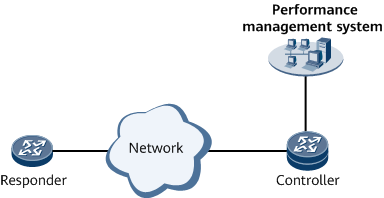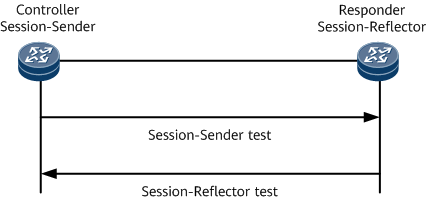Operation Process of TWAMP Light
A TWAMP Light service must be established before TWAMP Light is implemented.
Related Concepts
TWAMP Light has three measurement modes: on-demand, proactive, and periodic proactive measurement.
- On-demand measurement works in a specified period after being started. It can be performed once or periodically in the specified period.
- Proactive measurement works continuously after being started to collect statistics.
- Periodic proactive measurement works continuously at a specified interval.
Operation Process
Establishing a TWAMP Light service
The Controller and Responder are deployed as shown in Figure 1.
- The Control-Client on the Controller creates a TWAMP Light test session, and the Controller is specified as the Session-Sender.
- The Responder is specified as the Session-Reflector.
- The Session-Sender on the Controller starts the test session, and the Controller sends TWAMP-Test packets to the Responder based on the configured packet sending rate and packet template.
- The Responder responds to the TWAMP test packets.
Collecting performance statistics
TWAMP Light defines two types of TWAMP-Test packets: Test-request packets and Test-response packets.- Session-Sender test packets are sent from the Controller to the Responder.
- Session-Reflector test packets are replied by the Responder to the Controller.
In Figure 2, TWAMP-Test packets function as probes and carry the IP address and UDP port number that are predefined for the test session between the Controller and Responder. The Controller sends a TWAMP-Test packet to the Responder, and the Responder replies to it. The Controller collects TWAMP statistics. The performance measurement process is as follows:
The Controller collects statistics about the two-way delay, jitter, and packet loss rate based on the sequence numbers and timestamps carried in TWAMP-Test packets.
The Controller collects performance statistics based on TWAMP-Test packets and reports the statistics to the NMS. The NMS provides performance statistics for users.
In different measurement modes, the controller reports statistics to the NMS as follows:- On-demand measurement: reports statistics to the NMS using SNMP (MIBs).
- Proactive measurement: reports statistics to the NMS using Performance Monitoring (PM).
- Periodic proactive measurement: reports statistics to the NMS using PM.

